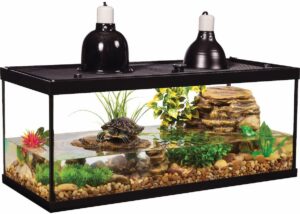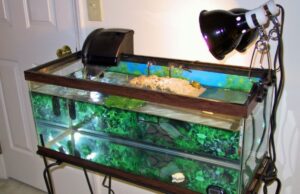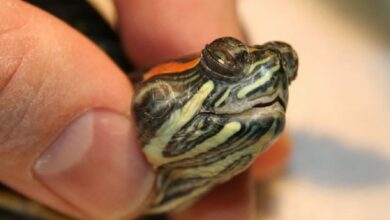How to Clean Your Turtle’s Tank
How to Clean Your Turtle’s Tank Properly
Setting up your turtle’s habitat is key to keeping them healthy. This needs to be right as this is where your pet will spend most of its time.
In this post, I will share with you the general guidelines to make your turtle’s home a good and clean one.
How to Choose a Turtle Tank
The first thing you need to consider is your turtle’s size. Many start off weighing a few grams but can grow to be as big as 80 pounds. So, research the type of turtle you will get so that you can buy a turtle tank that will suit your pet turtle. You can also start small and then build a bigger one as your turtle grows.
For example, some turtles hibernate, while others don’t. Not allowing your turtle to hibernate can result in health issues down the road. If your turtle is from a tropical environment, you want to ensure that the temperature is constantly warm throughout the year.
Some people provide small enclosures. Most turtles in the wild occupy at least half a mile areas, so putting them in a little cage is like taking your turtles to one square mile and keeping it in a room that they can never leave.
If possible, it is a good idea to give your turtles outdoor space to roam around. Most turtles don’t do well long-term indoors unless the care is excellent. If the weather permits, place your turtle’s habitat outside.
Materials Need For the Tank
For your turtle’s tank, you need to purchase the following:
Habitat
There are many different materials you can use for this, but it is recommended to use plastic tubs or troughs, kiddie pools, and Christmas tree boxes. If you have an aquatic turtle, a fish tank is a good idea. You can also use plastic bins over aquariums as these are easier to clean and weigh less than glass aquariums.
Rocks to Lie On
Most turtles like to sunbathe. However, ensure that the rocks are bigger than the size of your turtle’s head to prevent them from consuming too small rocks.
Thermometer or temperature gun
Use this device to check the temperature of the water
Food: Fresh and Pelleted
- Protein: Feed turtles wax worms or comet goldfish, mealworms, and crickets a few times a week
- Vegetables: Serve 1 to 2 teaspoons of dark, leafy greens such as mustard greens, collards, or kale three or four times a week
- Commercial turtle food: Turtles also like frozen or freeze-dried fish food, turtle pellets, or canned turtle food.
UV Light and a Heat Lamp
UV light is like a natural light of the sun, so make sure you put this but set it on a timer, so it mirrors the patterns of the sun. Turtles need UV light to avoid getting sick and having problems. Most turtles’ internal body functions are dependent on the temperature. This means they need to move through different temperatures to do things internally.
However, don’t disregard the sunlight as it is a good source of Vitamin D, which helps them absorb calcium from the food they are eating.
Most turtles spend time underground, so ensure to build habitats where they can hide under, just like what they do in the wild. Try using a dome-shaped hallowed wooden log and wet it a bit to keep its humidity. If you have an aquatic turtle, check the water frequently and monitor the ammonia levels and de-chlorinate when needed.
How to Set Up a Turtle Tank
Position the heat lamp on one side and the UV light on the other. This gives the turtle a chance to spend time in the hot and cold areas. Avoid putting your turtle’s tank in place with changing temperature. Keep also the tank away from the kitchen as turtles might carry Salmonella bacteria, which can affect your food.
How to Clean a Turtle Tank
When cleaning the turtle tank, you need to remove everything from inside it. Once taken out, clean the tank with a dilute warm water bleach solution to kill the bacteria. Then, let the tank sit for ten minutes then rinse the cleaning solution with water, and let it dry for some hours.
Replace all the substrate (either crushed walnut shells, coconut shells, wood shavings, aspen, or peat moss) with fresh materials. Soak rocks in soapy water, trim back plants, and remove any algae. Anytime you handle turtles or the tank, you should use gloves or wash your hands immediately afterward.
How often you clean depends on the kind of turtle you have and how dirty they are. It is recommended to clean a moist tank once or twice a month and dry the tank every few months. You want to clean by picking up feces regularly. Deep cleanings can happen every so often.






